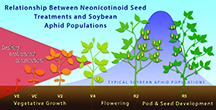January 7, 2016
Publication recaps academic research on neonicotinoids
 |
|
In this illustration, the red-shaded area represents the relative concentration of a neonicotinoid pesticide and the blue-shaded area represents the relative concentration of the soybean aphid population in a typical year. According to a new publication summarizing academic research, so-called “neonics” provide protection for a maximum of three weeks after planting and are ineffective against later-emerging threats such as soybean aphids. (Purdue Agricultural Communication graphic/Dan Annarino) |
WEST LAFAYETTE, Ind. - Neonicotinoid insecticides applied as a coating to soybean seeds provide a maximum of three weeks of protection after planting and are ineffective against later-emerging threats such as soybean aphids, according to a new publication by researchers from Purdue and 12 other Midwest universities.
The Purdue Extension publication, The Effectiveness of Neonicotinoid Seed Treatments in Soybean, summarizes current research on both the crop protection benefits of neonicotinoids and some of the unintended consequences that have been documented since their widespread introduction as corn and soybean seed treatments about 12 years ago.
Christian Krupke, professor of entomology at Purdue and one of the authors, said the publication is intended as an information resource for farmers.
“We wanted to develop a quick reference guide with research results addressing the utility, efficacy and fit of neonicotinoid seed treatments in soybean pest management,” he said. “Our goal is to help producers assess if and when these products fit for them and make the best possible decisions for their particular field conditions.”
Neonicotinoids became widely available in the mid-1990s and first gained popularity in horticulture crops partly because pests had become immune to other insecticides. In addition, the “neonics,” as they are commonly called, are less toxic to mammals than many older insecticide classes.
Beginning in the early 2000s, neonicotinoids were increasingly used as seed treatments for field crops. More than 80 percent of corn and 40 percent of soybean acres nationally are planted with neonicotinoid-treated seed.
Published research has shown that while neonicotinoids can be effective in controlling sporadic and inconsistent early-season threats such as wireworms or white grubs, they lose effectiveness well before midsummer, which is usually when the most potentially destructive soybean pest, the soybean aphid, begins to colonize soybean fields across the Midwest.
Other publications have also shown that neonicotinoids spread readily through the environment and could pose a threat to beneficial species.
“Planter dust, which is generated during and shortly after planting neonicotinoid-treated seeds, contains high concentrations of neonicotinoid insecticides,” the publication says. “Dust can move beyond field margins and land on flowers and other vegetation and potentially expose non-target insects (including honeybees and other pollinators).”
In addition, “Neonicotinoids are highly soluble in water, which facilitates movement beyond field borders via tile drainage and runoff,” the publication says.
Most soybean pests, including soybean aphid, can be managed using an integrated pest management approach, which includes a combination of scouting and insecticide use when needed. The authors recommend that farmers consult with their local university Extension services for recommendations on specific pest management strategies in their state.
The publication was a joint effort of Purdue, Iowa State University, Kansas State University, the University of Nebraska-Lincoln, North Dakota State University, Michigan State University, the University of Minnesota, the University of Missouri, Ohio State University, Penn State University, South Dakota State University, Texas A&M University and the University of Wisconsin.
The full publication is available from Purdue’s The Education Store at: https://www.edustore.purdue.edu/item.asp?Item_Number=E-268-W.
Writer: Darrin Pack, 765-494-8415, dpack@purdue.edu
Sources: Christian Krupke, 765-494-4912, ckrupke@purdue.edu
Agricultural Communications: (765) 494-2722;
Keith Robinson, robins89@purdue.edu
Agriculture News Page

